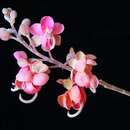Comprehensive Description
provided by North American Flora
Cassia grandis L.f. SuppL 230. 1781
Cassia brasiliana Lam. Encyc. 1: 649. 1785. Cathartocarpus grandis Pers. Syn. 1: 459. 1805.
A tree, up to 20 m. high, the young twigs pubescent. Stipules very small, linear, fugacious; leaves about 3 dm. long or less, densely finely puliescent all over; petiole 2-6 cm. long; leaflets 8-20 pairs, oblong, nearly sessile, obtuse at both ends, or the upper ones narrowed at the base, 3-5 cm. long; racemes lateral or axillary, drooping, pubescent, 1-2 dm. long; pedicels 1-2 cm. long; sepals ovate-oblong, obtuse, canescent, 6-8 mm. long; petals orbicular, reddish or purplish, about 12 mm. broad; legume compressed-cylindric, indehiscent, transversely rugose, septate between the seeds, 9 dm. long or less.
Type locality: Surinam.
Distribution: Jamaica; Cuba; Hispaniola; Porto Rico; Tobago, Trinidad; Guerrero to Panama , Colombia and Dutch Guiana. Brazil (?).
- bibliographic citation
- Nathaniel Lord Britton and Joseph Nelson Rose. 1928. (ROSALES); MIMOSACEAE. North American flora. vol 23(1). New York Botanical Garden, New York, NY
Physical Description
provided by USDA PLANTS text
Perennial, Trees, Woody throughout, Nodules present, Stems erect or ascending, Stems greater than 2 m tall, Stems solid, Stems or young twigs glabrous or sparsely glabrate, Leaves absent at flowering time, Leaves alternate, Leaves petiolate, Stipules inconspicuous, absent, or caducous, Stipules setiform, subulate or acicular, Stipules deciduous, Stipules free, Leaves compound, Leaves even pinnate, Leaf or leaflet margins entire, Leaflets opposite, Leaflets 10-many, Leaves hairy on one or both surfaces, Inflorescence panicles, Inflorescence axillary, Inflorescence terminal, Bracts very small, absent or caducous, Bracteoles present, Flowers actinomorphic or somewhat irregular, Flowers zygomorphic, Calyx 5-lobed, Calyx hairy, Petals separate, Petals pinkish to rose, Petals orange or yellow, Banner petal narrow or oblanceolate, Wing petals narrow, oblanceolate to oblong, Keel tips obtuse or rounded, not beaked, Stamens 9-10, Stamens heteromorphic, graded in size, Stamens completely free, separate, Filaments glabrous, Filaments S-shaped, Anthers opening by basal or terminal pores or slits, Style terete, Fruit a legume, Fruit unilocular, Fruit indehiscent, Fruit elongate, straight, Fruit oblong or ellipsoidal, Fruit or valves persistent on stem, Fruit coriaceous or becoming woody, Fruit exserted from calyx, Fruit glabrous or glabrate, Fruit 3-10 seeded, Seeds embedded in gummy or spongy pulp, Seeds ovoid to rounded in outline, Seed surface smooth, Seeds o live, brown, or black.
Cassia grandis: Brief Summary
provided by wikipedia EN
Cassia grandis, one of several species called pink shower tree, and known as carao in Spanish, is a flowering plant in the family Fabaceae, native to the neotropics, that grows up to 30 m (98 ft). The species is distributed from southern México, to Venezuela and Ecuador. It grows in forests and open fields at lower elevations, and is known to be planted as an ornamental. In at least Costa Rica, its pods are stewed into a molasses-like syrup, taken as a sweetener and for its nutritional and medicinal effects, called Jarabe (or Miel) de Carao.
- license
- cc-by-sa-3.0
- copyright
- Wikipedia authors and editors

